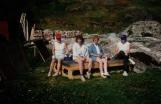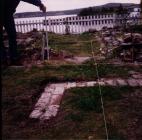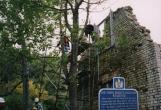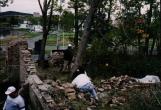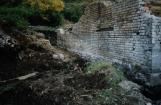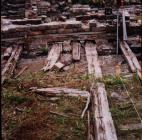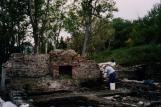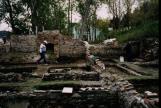1
ArchaeologyArchaeological investigations of the site of the Lester-Garland House were conducted in 1979, 1993, 1995, 1996 and 1997.
The 1979 and 1993 surveys were conducted by the Historic Resources Division of the Department of Tourism, Government of Newfoundland and Labrador. The latter occurred during a three-week period in August and September and indicated that a number of periods of occupation were represented at the site and that further field study was essential if reconstruction of the house was to proceed.
In 1995, as a condition of any restoration work, a Terms of Reference for an intensive archaeological investigation was prepared by the Historic Resources Division and given to The Trinity Trust. It required complete excavation of the interior of the ruins, an excavation around its perimeter and testing of all areas that would be impacted upon by associated reconstruction activities such as installation of underground pipes, cables, septic tank and drainage beds. This activity would provide information on the occupation of the site, both pre-Taverner and Aboriginal, as well as detailed information on the construction history of the ruins.
During a total of thirty-eight weeks in 1995 and 1996, the entire inside of the ruins were excavated to an underlying sterile soil composition, as was a 1.5 m wide buffer around the exterior perimeter of the building and all on-site areas where disturbance would occur. Also, the extant back wall and underlying stone foundations, about 75 % of the front wall, all interior stone partitions, the fireplaces and chimneys in the kitchen, dining room and conservatory areas and the entire foundation of the front porch were removed. This was necessary because the structures were unsafe or had deteriorated since the 1960s and could not support any reconstruction. In addition, the 1832 cellar was cleared of old brick and debris and the area of the entrance way and the ground between the cellar and house were cleared. Recordings were made, artifacts conserved and the structure was stabilized.
In the spring of 1997, it was necessary to complete additional excavations at the base of the cliff between the house and the Garland (Ryan) shop and along the side of the shop in order to install drainage pipes to accommodate water draining into the area from the hill. Evidence of the remains of a brick wall was found in close proximity to the south side of the shop.
Very early in the excavation it was noticed that a very distinct pattern existed in the types of materials found adjacent to the base of the foundations in the building or footing trenches. The remains of ceramics and clay smoking pipes were dated to a period later than the 1760s - the late 1700s and early 1800s. The soil which covered the remains of an earlier structure, the hearth-chimney-foundation complex, was found to contain the same soil layers and the same types of artifacts as were found against the foundations of the ruins. This probably indicates that the early hearth area was covered when the footing trenches were back-filled. Examination of materials in the mud and mortar contained in the stone foundations and brick walls, dated artifacts to the post-1780 period. It thus appears that the artifact assemblage retrieved for study inside the ruins were deposited as components of construction fill as opposed to having been deposited chronologically as a result of ongoing occupation.
Two important structural complexes were uncovered in 1995 and 1996. One was the early hearth-chimney-foundation complex now visible. The other was a drainage system constructed of brick, some lengths of which had a concave upper covering, which extended along the entire north side of the house, across the roadway and to the waters of the harbour. It is presumed that this drain extends to the base of the cliff at the rear of the house or to the cellar. The exposed drainage system has been mapped, drawn , photographed and back-filled with soil.
